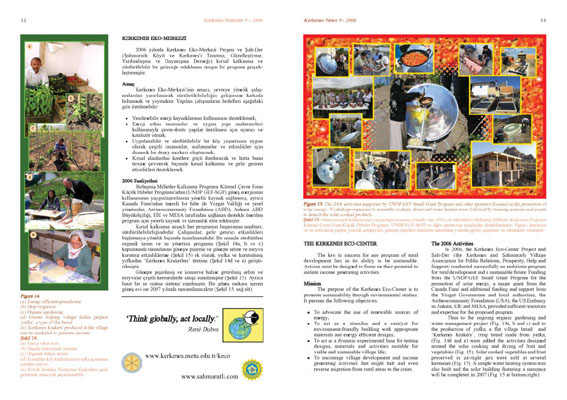THE KERKENES ECO-CENTER
In 2006,
the Kerkenes Eco-Center Project and Sah-Der (the Kerkenes and
Sahmuratli Village Association for Public Relations, Prosperity,
Help and Support) conducted successfully an ambitious program
for rural development and a sustainable future.
Mission
The
purpose of the Kerkenes Eco-Center is to promote sustainability
through environmental studies. It pursues the following objectives:
• To advocate the use of renewable sources of energy;
• To act as a stimulus and a catalyst for environment-friendly
building with appropriate
materials and energy efficient designs;
• To act as a dynamic experimental base for testing designs,
materials and activities suitable for viable and sustainable
village life.
• To encourage village development and income generating
activities that might halt and even reverse migration from rural
areas to the cities.
Funding from the UNDP-GEF Small Grant Program for the promotion
of solar energy, another major grant from the Canada Fund and
additional funding and support from the Yozgat Governorate and
local authorities, the Archeocommunity Foundation (USA), the
US Embassy in Ankara, EIE and MESA, provided sufficent resources
and expertise for the proposed program.
The key to success for any program of rural development lies
in its ability to be sustainable. Actions must be designed to
focus on their potential to initiate income generating activities.
Thus to the ongoing organic gardening and water management project
(Fig. 14a, b and c) and to the production of yufka, a flat village
bread and Kerkenes Krakers, crisp bread made from yufka, (Fig.
14d and e) were added the activities designed around the solar
cooking and drying of fruit and vegetables (Fig. 15).
Solar cooked vegetables and fruit preserved in air-tight jars
were sold at several kermeses (Fig. 15). A simple water heating
system was also built and the solar building featuring a sunspace
will be completed in 2007 (Fig. 15 at bottom right).



